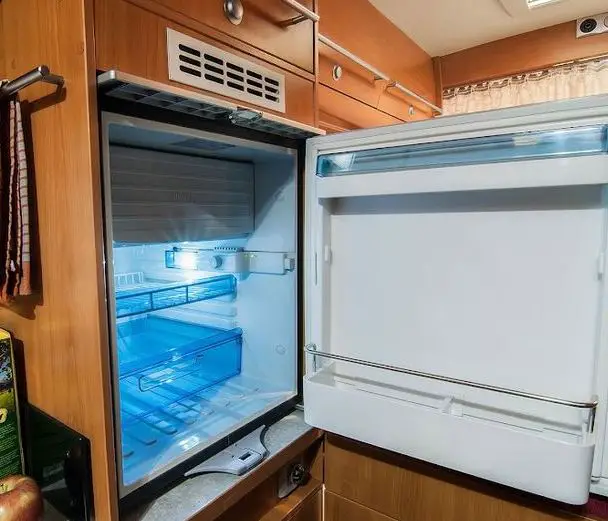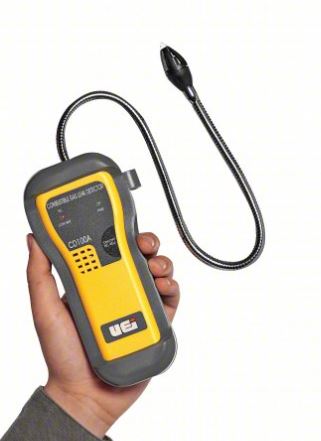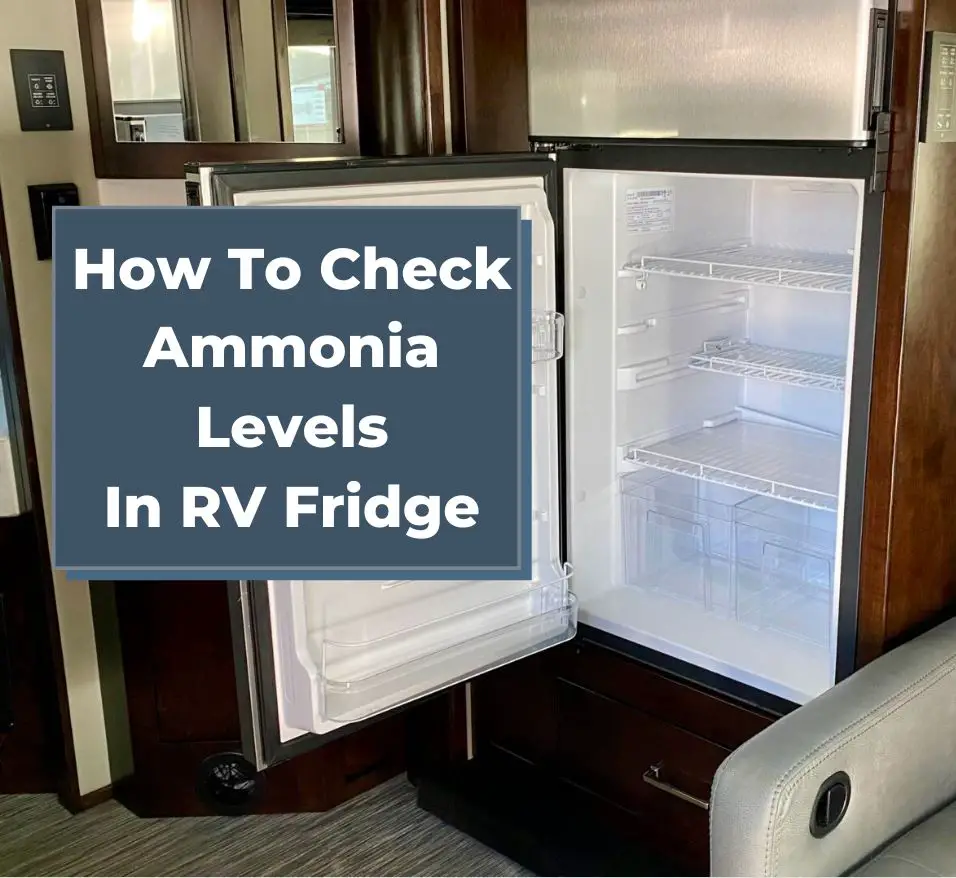If you’re an avid RV traveler, you know how important it is to have a functioning refrigerator in your vehicle, so knowing how to check ammonia levels in your RV fridge is really important. The RV fridge is responsible for keeping your food and drinks fresh and cool during your travels.
Checking the ammonia level in your RV fridge is crucial to ensure that it’s running efficiently. Low ammonia levels can cause your fridge to stop cooling properly, which can be frustrating and costly. Fortunately, there are several ways to check the ammonia level in your RV fridge that are easy and straightforward.
In this article, we’ll explore three methods that you can use to check the ammonia level in your RV fridge. We’ll also discuss the importance of regularly checking your fridge’s ammonia level and how to troubleshoot common issues that may arise. By the end of this article, you’ll have a better understanding of how to keep your RV fridge in top condition and enjoy your travels without worrying about spoiled food or drinks.
Why It’s Important to Check Ammonia Levels
Ammonia is a toxic gas that can be harmful in the confined space of an RV or camper. It is used as a refrigerant in RV fridges because it doesn’t deplete the ozone layer and is environmentally friendly. However, if there is a leak, it can pose a serious health risk to those inside the RV.
Exposure to ammonia can cause irritation to the eyes, nose, and throat, and can also lead to coughing, wheezing, and shortness of breath. High levels of exposure can cause severe respiratory damage and even death. Therefore, it is important to check the ammonia level in your RV fridge regularly to ensure that there is no leakage.
Aside from the health risks, ammonia leakage can also damage the RV fridge and other metal surfaces in the RV. It can cause corrosion and rust, which can lead to costly repairs or even replacement of the fridge.
If the ammonia levels in your fridge are too high, it can also cause the RV fridge to malfunction, leading to spoiled food and a costly repair bill. By checking the ammonia levels you’ll identify any potential issues before they become a bigger problem.
If the ammonia levels in your RV refrigerator are too low, it can cause the unit to run inefficiently, resulting in more power use.
Overall, checking the ammonia levels in your RV fridge is an important task that should be performed regularly to ensure that your fridge is functioning correctly, and your body and wallet will thank you for it.

Different Ways To Check RV Fridge Ammonia Levels
Smell Test
One of the easiest ways to check for ammonia levels in your RV fridge is to use your nose. Ammonia has a strong, unmistakable smell. If you detect a strong ammonia smell in your fridge, it’s likely that the ammonia levels are high. However, this method is not always reliable, as there are times when the smell may be faint or undetectable.
Check Your Food For The Taste Of Ammonia
Another way to check for ammonia levels in your RV fridge is to check the taste of your food. If your food tastes sour or has a strange aftertaste, it may be an indication that the ammonia levels in your fridge are too high. This method is also not always reliable, as some foods may naturally have a sour taste.
Litmus Paper
The litmus strip test is another method of determining the ammonia level in an RV fridge. These strips can be purchased online or at your local hardware store, and are very easy to use. Simply hold the strip inside your RV’s refrigerator and wait a moment. If the strip turns blue, that means that there are elevated levels of ammonia in the fridge.
Ammonia Detector
One of the easiest and most effective means of ammonia detection is to use an ammonia detector. They operate by measuring the ammonia level in the atmosphere, which indicates how to what degree it can penetrate all of the items in the fridge. To use an ammonia detector, simply turn it on and hold it near the fridge. The detector will take a reading and tell you how much ammonia is present in the air.
Ammonia Test Kit
Ammonia test kits come with all the necessary equipment to test the ammonia levels in your RV fridge. They are easy to use and provide accurate results. Closely follow the instructions in your kit kit to get the best results.
Check If Your Fridge Is Overheating
If your fridge is overheating, it may be an indication that the ammonia levels are too high. Check the temperature of your fridge to see if it is within the recommended range. If it’s not, then it could be a sign that the ammonia levels are too high.
Phenolphthalein Test Strips
Phenolphthalein test strips are another way to check for ammonia levels in your RV fridge. These strips change color in the presence of ammonia. Simply hold the strip inside your RV fridge’s box. If the strip changes to a pinkish color, that indicates the presence of ammonia.
Check For Yellow Stains
If you notice yellow stains in your RV fridge, it may be an indication that the ammonia levels are too high. These stains are caused by ammonia leaks. If you notice yellow stains, it’s important to take action immediately to prevent further damage to your fridge and potential harm to yourself.
Step-by-Step Guide To Check RV Fridge Ammonia Levels

Checking the ammonia level in your RV fridge is a simple process that can be done in a few easy steps. Here is a step-by-step guide to help you check the ammonia level in your RV fridge:
Step 1: Turn Off the Fridge
The first step is to turn off the fridge and unplug it from the power source. This will ensure that you can safely check the ammonia level or clean the refrigerator coils without any risk of electrical shock.
Step 2: Choose Your Detection Method
Next, you will need to decide which of the detection methods we outlined above that you wish to use. Using your sense of smell is cheapest, but the least reliable, while using an ammonia detector is the most expensive and the most reliable. Test strips and litmus paper fall somewhere in between.
Step 3: Test the Ammonia Level
Once you have the ammonia detector or litmus paper, you can test the ammonia level in your RV fridge. To do this, simply place the ammonia detector or litmus paper in the fridge and wait for a few minutes. If the ammonia level is high, the ammonia detector will beep or the litmus paper will change color.
If the ammonia level is low, you can continue using your RV fridge as usual. However, if the ammonia level is high, it may be time to consider getting your fridge serviced or repaired. High levels of ammonia can indicate a leak which can be dangerous and should be addressed as soon as possible.
By following these simple steps, you can easily check the ammonia level in your RV fridge and ensure that it is functioning properly. Remember to always prioritize safety when working with any appliances in your RV.
Common RV Refrigerator Problems and Solutions Related to Ammonia
RV fridges can sometimes experience problems with ammonia levels, and it is essential to identify and solve these issues to ensure the fridge is working correctly. Below are some common problems and solutions:
Strong Ammonia Smell
If you notice a strong ammonia smell coming from your RV fridge, it is likely that there is a leak. The leak could be caused by a variety of factors, including a cracked fridge tube or a corroded boiler.
The first step is to locate the leak. You can do this by checking for yellow spots on the fridge surface or using an ammonia detector. Once you have found the leak, you will need to repair or replace the damaged part. It is important to wear protective gloves and clothing when handling ammonia.
Fridge Not Cooling
If your RV fridge is not cooling, it could be due to a variety of reasons, including a faulty thermostat, a dirty condenser, or low ammonia levels.
Solution: Check the thermostat to ensure it is set correctly. Clean the condenser coils and fins to remove any dust or debris that may be blocking airflow. If the ammonia levels are low, you may need to recharge the fridge with ammonia. It is recommended that you have a professional perform this task.
Fridge Overheating
If your RV fridge is overheating, it could be due to a dirty condenser, low ammonia levels, or a faulty cooling unit.
Try cleaning the condenser coils and fins to ensure proper airflow. Check the ammonia levels and recharge the fridge if necessary. If the cooling unit is faulty, you will need to replace it. It is recommended that you have a professional perform this task.
By identifying and solving these common problems, you can ensure that your RV fridge is functioning correctly and keeping your food cold and fresh.
Conclusion
Checking the ammonia level in your RV fridge is a crucial task that every RV owner should know how to do. Doing so will help ensure that your fridge is functioning properly and that you and your family are safe from the harmful effects of ammonia poisoning.
There are several methods that you can use to check the ammonia level in your RV fridge. You can use litmus paper, a pH strip, or an ammonia detector instrument. Each method has its own advantages and disadvantages, so it’s important to choose the one that works best for you.
Remember that if you detect high levels of ammonia in your RV fridge, you should evacuate the area immediately and seek medical help. Ammonia poisoning can be deadly if left untreated, so it’s important to take action as soon as possible.
Regularly checking the ammonia level in your RV fridge is a simple task that can help ensure that your fridge is functioning properly and that you and your family are safe. By following the methods outlined in this article, you can easily check the ammonia level in your RV fridge and enjoy fresh, safe food on your next RV trip.
Check out our other RV repair and troubleshooting guides while you’re here:

